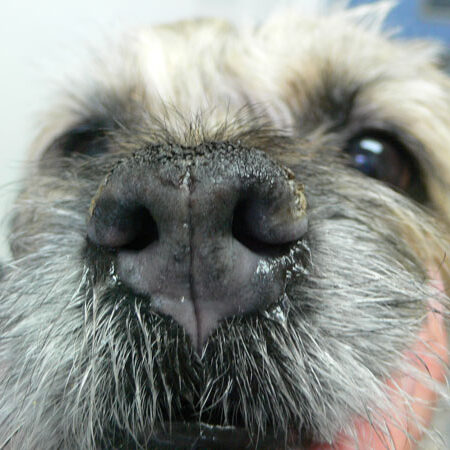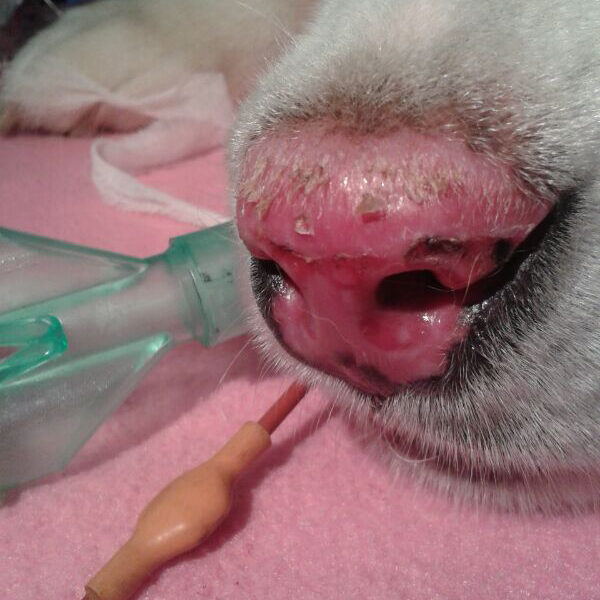Why Should I Bring my Pet to Willows for DLE?
Willows is one of Europe’s leading small animal referral centres. Our state-of-the-art hospital is led by internationally renowned Specialists who are committed to providing the highest standards of veterinary care. The Dermatology service at Willows is led by Dr Richard Harvey BVSc DVD DipECVD PhD FRSB FRCVS, who has extensive experience in diagnosing and treating dogs with DLE.
Our Dermatology service is supported by our multi-disciplinary team of Specialists across a number of disciplines including; Internal Medicine, Orthopaedics, Soft Tissue Surgery, Neurology, Ophthalmology, Oncology and Anaesthesia. In addition, Willows has a large dedicated team of Nurses and clinical support staff available 24 hours a day, every day of the year to provide the best possible care for your pet.
What is Discoid Lupus Erythematosus (DLE)?
DLE is a relatively common autoimmune skin disease of dogs. Autoimmune disease occurs when the immune system targets normal cells of the body resulting in inflammation and disease. In DLE, the immune system targets the skin, often around nose and it can extend to areas around the eyes, lips and ears. DLE is distinct from other forms of lupus in dogs that can cause internal disease along with more widespread skin disease.
What causes DLE?
The exact causes of DLE are not known, although genetic, hormonal and environmental factors are likely to be involved as they are in the human forms of lupus. In particular, sun exposure is likely to exacerbate or even induce the lesions of DLE.

How is DLE Diagnosed?
Careful examination of the affected skin will usually provide some clues. DLE usually starts with loss of pigmentation from the nose, which takes on a slate grey or blueish colour. The normal ‘cobblestone’ appearance of the nose is lost and areas of inflammation, crusting and ulceration develop (Fig 1 and 2). Despite these skin lesions, affected dogs remain otherwise healthy.
Figure 1: Depigmentation with loss of the ‘cobblestone’ appearance in a Border Terrier with DLE
Definitive diagnosis is achieved with a biopsy of affected skin, which can be tricky given the sensitive areas affected around the face. For this reason, biopsies to diagnose DLE are usually performed under general anaesthesia.


What Treatments are Available for DLE?
As DLE is caused by an abnormal immune response, treatment is centred on trying to reduce the inflammation. DLE is usually a localised disease, so effective control can often be obtained without the need for potent drugs given by mouth.
Topical creams and gels containing steroids or drugs called calcineurin inhibitors can be applied directly to the affected skin if animals allow this, and this approach helps to minimise side effects typically seen with oral medications.
If oral medication is required, the combination treatment of oxytetracycline and niacinamide is often helpful and is usually tolerated well with very few side effects. Vitamin E and fatty acid supplements are other options for milder cases of DLE and in more severe cases once disease is controlled. If clinical signs are severe, oral steroid medication is often required.
In all cases, sunlight exposure must be minimised with avoidance strategies and the use of sunscreens.
Figure 2: Marked inflammation, ulceration and crusting in a Labrador with severe DLE
What Can I Expect of my Dog is Treated for DLE?
The prognosis for DLE is usually good, and the disease usually remains limited to small areas of the skin. However, DLE is usually controlled rather than cured, and many cases need long term medication. Some cases can follow a more severe course, requiring more powerful drugs to control the disease.
To save this page as a PDF, click the button and make sure “Save as PDF” is selected.
Skin and Ear Clinic
Find out more
To assist owners whose pets have skin and ear conditions, we have put together a range of information pages to talk you through some of the more common dermatology conditions seen by our Specialist team.

